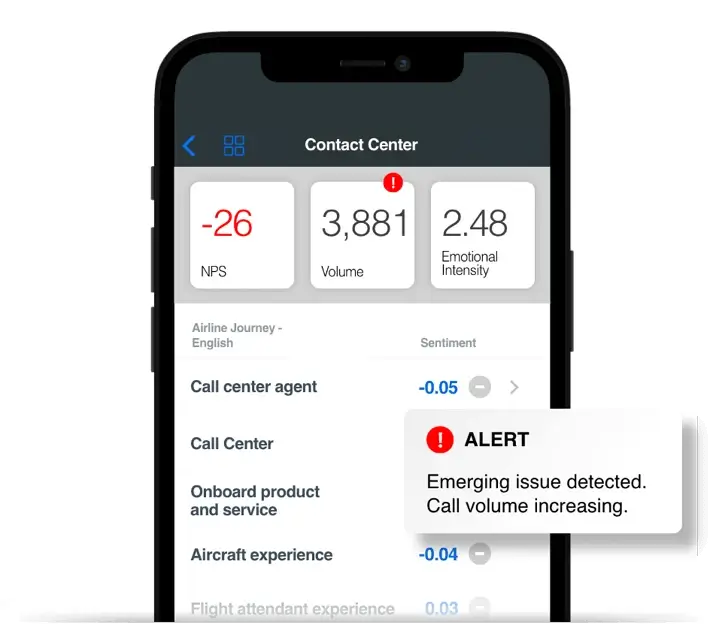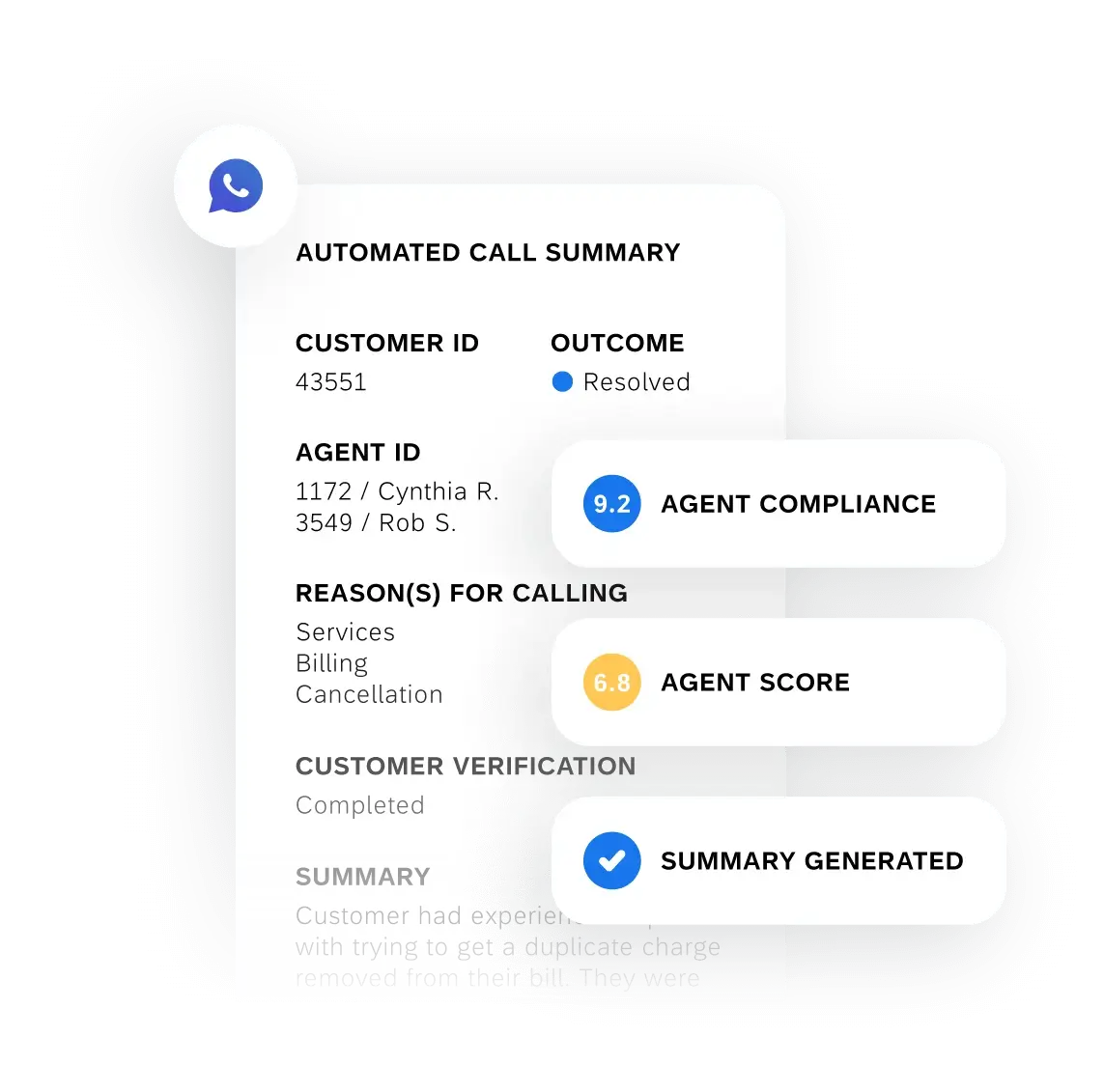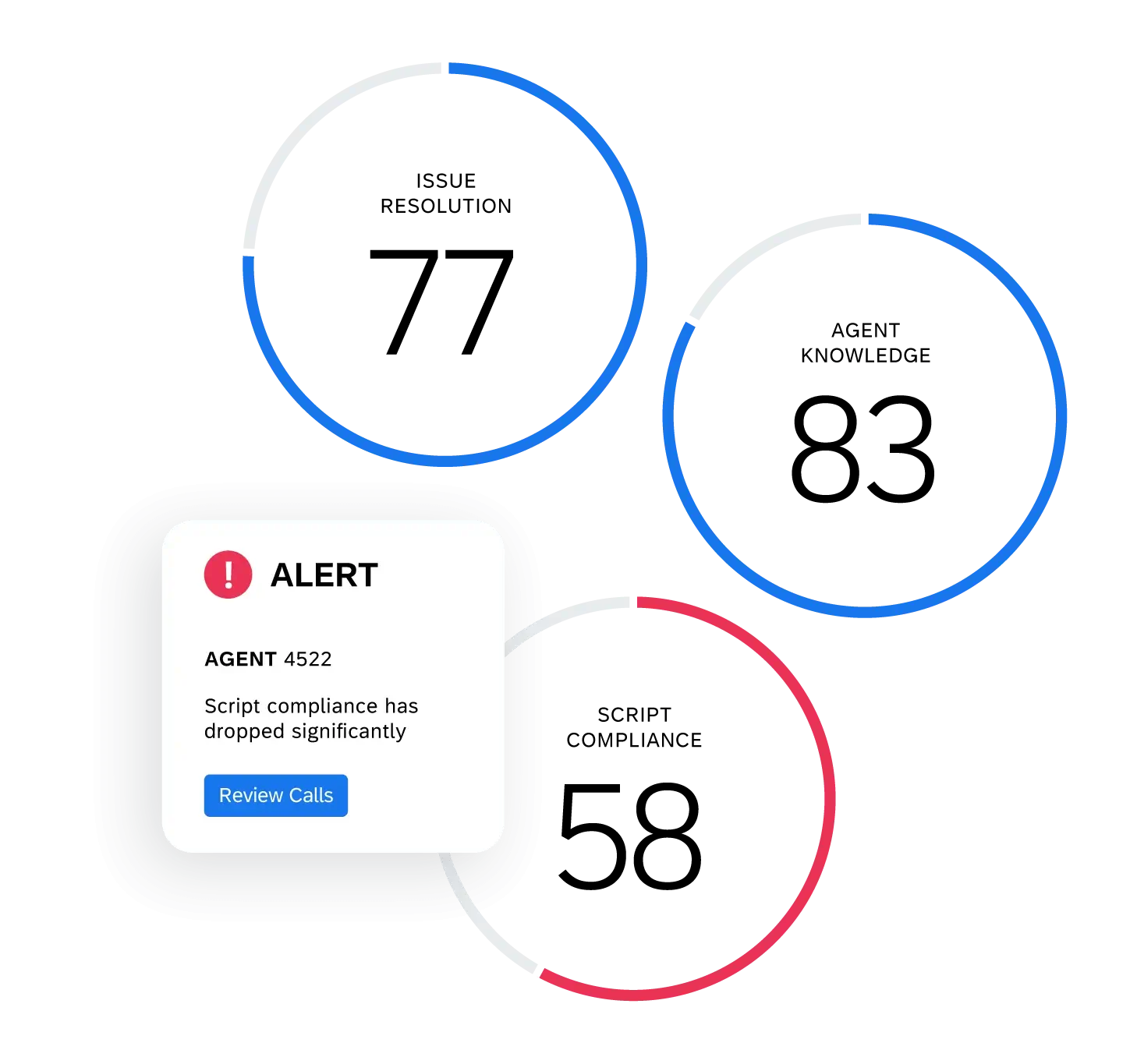Written by: Adam Bunker
Reviewed by: Harry Gough
What are call center metrics?
Call center metrics are how you track performance and improvement across all areas of a call center environment. When combined and compared over time, those metrics are how businesses report on call center KPIs (key performance indicators).
Call center performance metrics can help you answer a few key questions:
- How easy is it for a customer to get in touch with us?
- How quickly and efficiently are their issues being resolved?
- How happy are they with the experience?
- Where do we need to improve?
Call center performance metrics are usually tracked using call center software that can monitor and understand both the quantitative side of things (like the number of calls answered and active waiting calls) and more qualitative data (like customer effort and sentiment).
It’s impossible to improve any area of your business without measuring how things are currently going, and then using those measurements to compare against past and future performance. Every area of your business will have relevant metrics to track, and the call center is no different.
That’s because, as the nerve center of a traditional customer service setup, the call center is still a hugely important part of the customer experience. That means that tracking performance across a range of metrics – from agent productivity to customer issue resolutions – and taking action based on what those metrics show, is vital to building a customer experience that really shines.

What’s the difference between…
Contact center metrics and call center metrics
The term ‘contact center’ refers to a more omnichannel customer support offering than a call center – one in which customers can get in touch and have their issues resolved using a number of digital channels as well as just by phone.
As such, while contact center metrics will include those that are relevant for customer calls, they’ll also add ways to measure digital interactions. That might be things like the number of emails it takes to resolve an issue or the wait time for an agent to reply using a live chat feature.
Customer service metrics and call center metrics
Customer service metrics look beyond the call center to measure overall customer happiness. Typical metrics here include CSAT (customer satisfaction), NPS (Net Promoter Score), and CES (Customer Effort Score).
The call center plays a vital role in shaping these customer service metrics, but so do things like the in-store experience and issue resolution on social media channels. As such, you can think of customer service metrics as overarching KPIs that are informed by, among other things, your call center’s performance.
Free eBook: Moving your CX metrics forward
Why are call center metrics important?
The success of your call center depends on being able to take action on what you learn from tracking metrics. Get that right, and you’ll have happy, loyal customers who tell people how great their experience was.
Get it wrong, however, and people will look elsewhere. Accenture, for example, found that some 52% of US and UK customers will switch providers due to poor experiences. Where the call center comes into the equation here is that, in the same research, 90% of those customers cited an immediate response as a very important part of the puzzle.
Similar studies show that when a customer’s problem is resolved on the first call, 99% will stay loyal to that company, versus 85% who’ll look elsewhere due to having to make follow-up calls. Our own research found that 60% would actively buy more if companies treated them better.
“One customer well taken care of could be more valuable than $10,000 worth of advertising.”
– Jim Rohn
This is key: while omnichannel customer support is on the up and up, the call center is still a core part of any company’s customer service operation.
And while it’s tempting for companies to look to digital channels as the more modern and streamlined way to handle all customer interactions, the humble phone call will always be important. People will always want to speak to a real human being in certain circumstances.
Some 41% of Americans have recently used a landline to reach call customer service and those that do expect the same level of service as those using digital channels. Consistency is key, in other words. Salesforce suggests that 75% of consumers expect a consistent experience across all touchpoints – and that 73% will jump ship if that’s not on offer.
In tight economic times, that means expanding to digital channels without losing sight of call center quality. And the way to walk that tightrope effectively is to routinely measure metrics that can help you spot experience gaps, pain points, and areas for improvement.
What industry standard call center metrics are there?
Ok, so what exactly should call centers be monitoring and measuring? You can broadly map call center metrics into three groups:
- Agent-specific productivity metrics
- Call center operational metrics
- Customer experience metrics
Agent-specific productivity metrics
Handling time
This is how long agents spend on each call. It’s important to balance incentivizing speed of resolution without making customers feel as though they’ve been brushed off. And in fact, these metrics often need context. For example, if you are successfully deflecting simple everyday queries to cheaper, self-serve channels, you would actually expect your average handle time to increase – because agents are free to spend time on more complex, time consuming issues.
Utilization rate
Utilization rate describes how long an agent is available in reference to their overall shift length. The goal is to reduce time spent on post-call work and other time-consuming tasks so that each agent can spend more time being available for calls.
Speed of answer
How long does each agent take to answer a call? The industry average is 28 seconds, but the target is often stated to be 20 or under.
Call center operational metrics
Active waiting calls
This speaks to the number of people who have to wait on hold. Obviously, the goal should be to get people through to an agent with as little time on hold as possible.
Calls handled
This metric speaks for itself: it’s the number of calls where customers got through to an agent. It doesn’t matter whether their issue was resolved or not, just if they got to speak to someone.
Percentage of calls blocked
In this context, a ‘blocked’ call is one where a customer can’t be answered – usually due to all agents being too busy and the queue reaching capacity.
Average call abandonment rate
Divide the total number of abandoned calls by the total number of handled calls, and you’ll have a figure for how many people were forced to give up trying to get through.
Cost per call (CPC)
Each and every call has a cost value associated with it, defined by the number of calls you take in relation to the overall cost of running your call center. The higher the volume of calls you get through (and ideally resolve), the lower your cost per call.
Peak hour traffic
It’s useful to monitor the volume of incoming calls at various points in the day, so you can see where traffic spikes arise. For instance, you might find that more people call during their lunch break – this information would help you ensure that there are more agents on hand during those specific hours.
Call arrival rate
Call arrival rate describes how many calls you receive per minute, hour, day, week, month, or year. That includes dropped, blocked, or otherwise unhandled calls.
Average call lengths
The longer the call, the less time each agent has to take on further calls, and the longer each customer is likely to spend on hold. Many of these metrics are interconnected, where working to improve one will naturally affect others.
Average age of query
How long do people need to wait to have their problems resolved? If you don’t solve a customer’s issue quickly and within one call, the ‘age of query’ for that customer will grow exponentially until the call or interaction that ultimately closes the ticket.
Callback requests
Sometimes, customers who can’t get through to an agent are offered the option to receive a callback at a time to suit them. This metric tracks the number of people who opt for that service, which – in most cases – shows how many people aren’t getting their issues resolved at first contact.
Repeat calls
If a customer needs to call back to have their issue resolved, something’s gone wrong. The goal should be to reduce repeat calls to as close to zero as possible.
Customer experience metrics
First contact resolution
This one’s really crucial. First contact resolution looks at the percentage of calls in which customers’ queries or issues can be solved there and then – rather than ones that require follow-up, transfers, or repeat calls.
Customer satisfaction Score (CSAT)
CSAT (customer satisfaction) is an industry-standard way to see how people felt that their customer support interaction went. A customer satisfaction survey question might ask ‘How would you rate your overall satisfaction with the telephone service you received?’, as an example, and prompt the customer for a score between one to five (very unsatisfied to very satisfied).

Customer Effort Score (CES)
CES looks to give a numerical value to the effort a customer felt they had to exert to get the resolution they were looking for. This is usually garnered through survey questions and is really important for assessing how easy the call center experience feels from the outside.
Net Promoter Scores (NPS)
Like CSAT (customer satisfaction), NPS uses a survey to understand how positive a specific interaction was, this time through the lens of the likelihood to recommend your company to others. If things went well when they got in touch with your call or contact center, customers will be much more likely to tell their friends or colleagues to give your products a go.
How is call center efficiency measured?
Traditionally, the efficiency of a call center has been measured based on the volume of handled calls. This is referred to as your ‘Call Center Service Level’, and calculating it would simply involve tracking the number of calls answered in a given timeframe.
If, for instance, you determine that it should be 50 calls an hour based on current averages, but your call center agents actually answer 30 during a given hour, then it becomes easy to see that performance is tracking lower than average. And in that case, your efficiency needs improving.
Alongside this, call centers have always strived to achieve a few industry-standard benchmarks, like ensuring that ringing calls are answered within 20 seconds.
In the modern call center environment, however, efficiency goes hand in hand with customer experience – in that the two always affect one another. What that means in practice, is that it’s vital to track more than just raw operational data.
In fact, it’s important to track as many metrics as possible concurrently and then focus on any trends or interconnected metrics that point to problem areas. The best way to do this is with call center software that can automatically monitor everything from that raw operational figures to the more experiential, human data.
With that in mind, let’s take a look at a few ways in which the right software can help streamline and improve every call center metric…
How to improve call center metrics
Capturing metrics around things like inbound calls, calls answered, and the customer experience is all well and good, but it’s useless if you don’t use them to take action.
Improvement is the result of learning what needs fixing, after all, so let’s look at how to do just that, in order to improve customer satisfaction at every step.
1. Capture call center metrics automatically
Manual sampling of calls is a great way to miss out on a lot of information, and a ton of nuance. Instead, call center KPIs should be continually tracked, both in real-time and across long periods, using software that can monitor every facet of every call is the best way for customer service managers to learn what’s really happening.
We’ve discussed how interconnected many KPIs are, and it’s the trends that emerge when you’re capturing everything – including things like customer comments about their experience on third-party websites – that really show areas for improvement. The right call center solution can help.
2. Empower your agents
Call center agents are the beating heart of customer service, so it pays to help them do their job to the best of their abilities, rather than simply praise or admonish them for the number of calls answered, or how many customers they’ve helped.
Again, the right software can help here. With AI and natural language processing, your call center solution can monitor calls as they happen and understand things like customer sentiment, effort, and intent – then use that insight to prompt agents with advice on how to proceed and deliver a solution based on that understanding and full, contextual customer history. It removes the guesswork, giving agents the tools and the skills to improve every customer interaction, and the metrics they are judged against. Beyond this, automated workflows can help reduce the burden of tedious, manual processes like after-call work.

For call center managers, meanwhile, these same tools can take the stress out of coaching. Script compliance is automatically measured, with scoring and coaching opportunities automatically highlighted and scheduled. The result is better-informed agents and a call center team working at the top of their game.
3. Make data-informed decisions
The right customer data can be a goldmine for any business, but measuring call center KPIs and insights can benefit more than just customer service teams. Collecting call-specific metrics, tracking sentiment, and capturing customer feedback across every touch point can help businesses make informed decisions about everything from the UX of their websites to the look and feel of their products.
When call centers put the data they’re able to collect about customer pain points to work, the overall customer experience can improve massively. That can help drive greater customer satisfaction and reduce the overall number of customer issues at the same time.
Supercharge every interaction
If you’re looking for a way to drive customer satisfaction, boost call center KPIs, and turn the age-old ‘too many calls’ problem into actionable insight, Qualtrics can help.
Qualtrics’ pioneering contact center experience software is powered by AI, natural language processing, and a deep understanding of the issues faced by leading customer support teams.
It helps customer service leaders and contact centers at some of the world’s biggest companies drive continual improvement in everything from call volume handling to agent script compliance – all with real-time data collection and an empathetic understanding of every single customer interaction, on every single channel.

We know that the call center is as important today as it’s ever been, but we also know that, for business leaders, it’s now just one part of a wider, more omnichannel contact center approach.
To that end, our contact center experience software can help contact center and call center managers join the dots, with cross-channel insight that lights the way toward greater customer satisfaction, loyalty, and a smoother customer experience at every step.
Free eBook: Moving your CX metrics forward